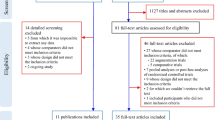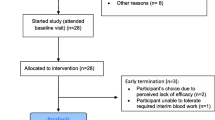Abstract
Several reports have described salutary effects such as decreased physical aggression and improved social responsiveness being associated with the administration of high doses of pyridoxine and magnesium (HDPM) in open-labeled and controlled studies of patients with autism. Despite this fact, this intervention remains controversial. A 10-week double-blind, placebo-controlled trial was undertaken to examine both the efficacy and safety of HDPM in autism. Twelve patients were enrolled, and 10 patients (mean age 6 years 3 months) were able to complete the study. HDPM at an average dose of 638.9 mg of pyridoxine and 216.3 mg of magnesium oxide was ineffective in ameliorating autistic behaviors as assessed by the Children's Psychiatric Rating Scale (CPRS), the Clinical Global Impression Scale, and the NIMH Global Obsessive Compulsive Scale. Furthermore, no clinically significant side effects were noted during HDPM administration. A trend for a transient change on the CPRS was found that was possibly due to a placebo response. This study raises doubts about the clinical effectiveness of HDPM in autistic disorder.
Similar content being viewed by others
REFERENCES
Aman, M. G., Van Bourgondien, M. E., Wolford, P. L., & Sarphare, G. (1995). Psychotropic and anticonvulsant drugs in subjects with autism: Prevalence and patterns of use. Journal of the American Academy of Child and Adolescent Psychiatry, 34, 1672–1681.
American Academy of Pediatrics, Committee on Nutrition. (1976). Megavitamin therapy for childhood psychoses and learning disabilities. Pediatrics, 58, 910–912.
American Psychiatric Association. (1987). Diagnostic and statistical manual of mental disorders (3rd ed., rev.). Washington DC: Author.
Anderson, L. T., Campbell, M., Grega, D. M., Perry, R., Small, A. M., & Green, W. H. (1984). Haloperidol in the treatment of infantile autism: Effects on learning and behavioral symptoms. American Journal of Psychiatry, 141, 1195–1202.
Campbell, M., & Palij, M. (1985). Behavioral and cognitive measures used in psychopharmacologic studies of infantile autism. Psychopharmacology Bulletin, 21, 1047–1053.
Campbell, M., Anderson, L. T., Small, A. M., Adams, P., Gonzalez, N. M., & Ernst, M. (1993). Naltrexone in autistic children: Behavioral symptoms and attentional learning. Journal of the American Academy of Child and Adolescent Psychiatry, 32, 1283–1291.
Coleman, M., Steinberg, G., Tippett, J., Bhagavan, H. N., Coursin, D. B., Gross, M., Lewis, C., & DeVeau, L. (1979). A preliminary study of the effect of pyridoxine administration in a subgroup of hyperkinetic children: A double-blind crossover comparison with methylphenidate Biological Psychiatry, 14, 741–751.
DeVeaugh-Geiss, J., Moroz, G., Biederman, J., Cantwell, D., Fontaine, R., Greist, J. H., Reichler, R., Katz, R., & Landau, P (1992). Clomipramine hydrochloride in childhood and adolescent obsessive-compulsive disorder—a multicenter trial. Journal of the American Academy of Child and Adolescent Psychiatry, 31, 45–49.
DiLalla, D. L., & Rogers, S. J. (1994). Domains of the Childhood Autism Rating Scale: Relevance for diagnosis and treatment. Journal of Autism and Developmental Disorders, 24, 115–128.
Dolske, M. C., Spollen, J., McKay, S., Lancashire, E., & Tolbert, L. (1993). A preliminary trial of ascorbic acid as supplemental therapy for autism. Progress in Neuropsychopharmacology and Biological Psychiatry, 17, 765–774.
Eisenberg, D. M., Kessler, R. C., Foster, C., Norlock, F. E., Calkins, D. R., & Delbanco, T. L. (1993). Unconventional medicine in the United States. New England Journal of Medicine, 328, 246–252.
Ernst, M., Devi, L., Silva, R. R., Gonzalez, N. M., Small, A. M., Malone, R. P, & Campbell, M. (1993). Plasma beta-endorphin levels, naltrexone, and haloperidol in autistic children. Psychopharmacology Bulletin, 29, 221–227.
Frankhauser, M. P., Karumanchi, V. C., German, M. L., Yates, A., & Karumanchi, S. D. (1992). A double-blind, placebo-controlled study of the efficacy of transdermal clonidine in autism. Journal of Clinical Psychiatry, 53, 77–82.
Gillberg, C., Wahlstrom, J., Johansson, R., Tornblom, M., Albertson-Wikland, K. (1986). Folic acid as an adjunct in the treatment of children with the autism fragile-X syndrome (AFRAX). Developmental Medicine & Child Neurology, 28, 624–627.
Gonzalez, N. M., Campbell, M., Small, A. M., Shay, J., Bluhm, L. D., Adams, P. B., & Foltz, R. L. (1994). Naltrexone plasma levels, clinical response and effect on weight in autistic children. Psychopharmacology Bulletin, 30, 203–208.
Gordon, C. T., Rapoport, J. L., Hamburger, S. D., State, R. C., & Mannheim, G. B. (1992). Differential response of seven subjects with autistic disorder to clomipramine and desipramine. American Journal of Psychiatry, 149, 363–366.
Gordon, C. T., State, R. C, Nelson, J. E., Hamburger, S. D., & Rapoport, J. L. (1993). A double-blind comparison of clomipramine, desipramine, and placebo in the treatment of autistic disorder. Archives of General Psychiatry, 50, 441–447.
Goyette, C. H., Conners, C. K., & Ulrich, R. F. (1978). Normative data on revised Conners parent and teacher rating scales. Journal of Abnormal Child Psychology, 6, 221–236.
Hanning, R. M., & Zlotkin, S. H. (1985). Unconventional eating practices and their health implications. Pediatric Clinics of North America, 32, 429–445.
Insel, T. R., Murphy, D. L., Cohen, R. M., Alterman, I., Kilts, C., & Linnoila, M. (1983). Obsessive-compulsive disorder: A double-blind trial of clomipramine and clorgyline. Archives of General Psychiatry, 40, 605–612.
Jakobs, C., Jaeken, J., & Gibson, K. M. (1993). Inherited disorders of GABA metabolish. Journal of Inherited Metabolic Disease, 16, 704–715.
Jaselskis, C. A., Cook, E. H., Jr., Fletcher, K. E., & Leventhal, B. L. (1992). Clonidine treatment of hyperactive and impulsive children with autistic disorder. Journal of Clinical Psychopharmacology, 12, 322–327.
Kolmen, B. K., Feldman, H. M., Handen, B. L., & Janosky, J. E. (1995). Naltrexone in young autistic children; A double-blind, placebo-controlled crossover study. Journal of the American Academy of Child and Adolescent Psychiatry, 34, 223–231.
Lelord, G., Muh, J. P., Barthelemy, C., Martineau, J., Garreau, B., & Callaway, E. (1981). Effects of pyridoxine and magnesium on autistic symptoms-initial observations. Journal of Autism and Developmental Disorders, 11, 219–230.
Leventhal, B. L, Cook, E. H., Jr., Morford, M., Ravitz, A. J., Heller, W., & Freedman, D. X. (1993). Clinical and neurochemical effects of fenfluramine in children with autism. Journal of Neuropsychiatry and Clinical Neurosciences, 5, 307–315.
Martineau, J., Barthelemy, C., Gareau, B., & Lelord, G. (1985). Vitamin B6, magnesium, and combined B6-Mg: Therapeutic effects in childhood autism. Biological Psychiatry, 20, 467–478.
Martineau, J., Barthelemy, C., & Lelord, G. (1986). Long-term effects of combined vitamin B6-magnesium administration in an autistic child. Biological Psychiatry, 21, 511–518.
Martineau, J., Barthelemy, C., Cheliakine, C., & Lelord, G. (1988). Brief report: An open middle-term study of combined vitamin B6-magnesium in a subgroup of autistic children selected on their sensitivity to this treatment. Journal of Autism and Developmental Disorders, 18, 435–447.
McLachlan, R. S., & Brown, W. F. (1995). Pyridoxine dependent epilepsy with iatrogenic sensory neuronopathy. Canadian Journal of Neurologic Sciences, 22, 50–51.
Menage, P., Thibault, G., Barthélèmy, C., Lelord, G., & Bardos, P. (1992). CD4+CD45RA+T lymphocyte deficiency in autistic children: Effect of a pyridoxine-magnesium treatment. Brain Dysfunction, 5, 326–333.
National Institute of Mental Health. (1985). Clinical Global Impression Scale. Psychopharmacology Bulletin, 21, 839–843.
Overall, J. E., & Campbell, M. (1988). Behavioral assessment of psychopathology in children: Infantile autism. Journal of Clinical sychology, 44, 708–716.
Pauling, L. (1974). On the orthomolecular environment of the mind: Orthomolecular theory. American Journal of Psychiatry, 131, 1251–1257.
Pfeiffer, S. I., Norton, J., Nelson, L., & Shott, S. (1995). Efficacy of vitamin B6 and magnesium in the treatment of autism: A methodology review and summary of outcomes. Journal of Autism and Developmental Disorders, 25, 481–493.
Quintana, H., Birmaher, B., Stedge, D., Lennon, S., Freed, J., Bridge, J., & Greenhill, L. (1995). Use of methylphenidate in the treatment of children with autistic disorder. Journal of Autism and Developmental Disorders, 25, 283–294.
Rimland, B. (1988). Controversies in the treatment of autistic children: Vitamin and drug therapy. Journal of Child Neurology, 3(Suppl), S68–S72.
Rimland, B., Callaway, E., & Dreyfus, P. (1978). The effect of high doses of vitamin B6 on autistic children: A double-blind crossover study. American Journal of Psychiatry, 135, 472–475.
Schaumberg, H., Kaplan, J., Windebank, A., Vick, N., Rasmus, S., Pleasure, D., & Brown, M. J. (1983). Sensory neuropathy from pyridoxine abuse: A new megavitamin syndrome. New England Journal of Medicine, 309, 445–448.
Schopler, E., Reichler, R., DeVellis, R., & Daly, K. (1980). Toward objective classification of childhood autism: Childhood autism rating scale (CARS). Journal of Autism and Developmental Disorders, 10, 91–103.
Schulz, K. F., Chalmers, I., Hayes, R. J., & Altman, D. G. (1995). Empiric evidence of bias: Dimensions of methodological quality associated with estimates of treatment effects in controlled trials. Journal of the American Medical Association, 273, 408–412.
Spigelblatt, L., Laine-Ammara, G., Pless, B., & Guyver, A. (1994). The use of alternative medicine by children. Pediatrics, 94, 811–814.
Tolbert, L., Haigler, T., Waits, M. M., & Dennis, T. (1993). Brief report: Lack of response in an autistic population to a low dose clinical trial of pyridoxine and magnesium. Journal of Autism and Developmental Disorders, 23, 193–199.
Willemsen-Swinkels, S. H. N., Buitelaar, J. K., Nijhof, G. J., & van Engeland, H. (1995). Failure of naltrexone hydrochloride to reduce self-injuries and autistic behavior in mentally retarded adults: Double-blind placebo-controlled studies. Archives of General Psychiatry, 52, 766–773.
Wolraich, M. L., Wilson, D. B., & White, J. W. (1995). The effect of sugar on behavior or cognition in children: A meta-analysis. Journal of the American Medical Association, 274, 1617–1621.
Author information
Authors and Affiliations
Rights and permissions
About this article
Cite this article
Findling, R.L., Maxwell, K., Scotese-Wojtila, L. et al. High-Dose Pyridoxine and Magnesium Administration in Children with Autistic Disorder: An Absence of Salutary Effects in a Double-Blind, Placebo-Controlled Study. J Autism Dev Disord 27, 467–478 (1997). https://doi.org/10.1023/A:1025861522935
Issue Date:
DOI: https://doi.org/10.1023/A:1025861522935




